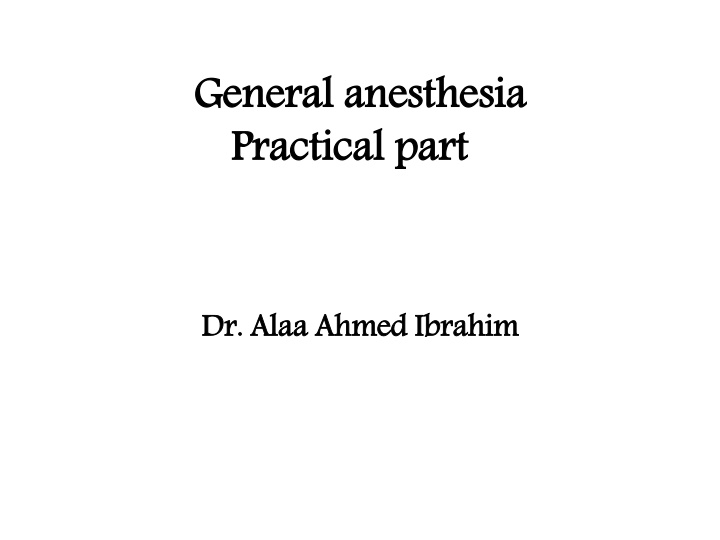
The Stages of General Anesthesia in Veterinary Practice
Explore the stages of general anesthesia in veterinary practice, from voluntary movement to surgical anesthesia. Learn about the signs and characteristics of each stage, guiding you through safe and effective anesthesia management for animals.
Download Presentation

Please find below an Image/Link to download the presentation.
The content on the website is provided AS IS for your information and personal use only. It may not be sold, licensed, or shared on other websites without obtaining consent from the author. If you encounter any issues during the download, it is possible that the publisher has removed the file from their server.
You are allowed to download the files provided on this website for personal or commercial use, subject to the condition that they are used lawfully. All files are the property of their respective owners.
The content on the website is provided AS IS for your information and personal use only. It may not be sold, licensed, or shared on other websites without obtaining consent from the author.
E N D
Presentation Transcript
General anesthesia Practical part General anesthesia Practical part Dr. Dr. Alaa Ahmed Ibrahim Alaa Ahmed Ibrahim
Stages of general anesthesia Stages of general anesthesia First stage (voluntary movement) Stage II (involuntary movement) delirium stage Delirium stage Stage of surgical anesthesia Overdosage stage
Signs of stage I Nervous animals are bound to resist restraint. Animals may struggle violently and voluntarily Breath holding of animal for short periods. Strong and rapid heart beat Pupillary dilation Salivation , urination , and defecation are frequent in some species
Signs of Stage II (involuntary movement) delirium stage Loss all voluntary control of the animals Animal React to external stimuli by violent reflex struggling Fast and strong heartbeat , cardiac arrhythmia widely dilated pupil Nystagmus commonly occur in horses. Animals may whine, cry, bellow, or neigh salivation in ruminants and cats Vomiting in dogs, cats , and goats In cat and pig , larynx is very sensitive in this stage and stimulation may cause laryngeal spasms
Signs of Stage II (involuntary movement) delirium stage Jaw tone is still present at this stage and endotracheal intubation in dog and cat may initiate vomition and active regurgitation in ruminants stimulation of any kind of reflexes should be avoided because of the exaggerated reflex responses during this stage
Stage III (stage of surgical anesthesia ) This stage characterized by unconsciousness with progressive depression of the reflexes. Muscular relaxation develops Ventilation becomes slow and regular Vomiting and swallowing reflexes are lost This stage is divided into three planes : Light anesthesia Medium anesthesia following reflexes laryngeal reflex , palpebral reflex, corneal reflex, and adequate muscle relaxation and analgesia for most surgical procedures Deep anesthesia muscle relaxation, diaphragmatic breathing and centered and dilated pupil Signs of Signs of Stage III ( stage of surgical anesthesia ) This stage characterized by This stage is divided into three planes :- - Light anesthesia persists until eyeball movement stop. Medium anesthesia stable respiration and pulse rate, absent of the Deep anesthesia decrease intercostal muscle function, profound
Signs of light anesthesia Eyeballs are generally turned downward in dogs, cats , and pigs and eyelids are usually closed Photo motor reflex(constriction of the pupil on exposure to light stimuli ) is present Nystagmus and lacrimation in horses Palpebral reflex( blink induced by touching the eyelids) is present Corneal reflex(Blinking induced by gently touching the cornea) is present Signs of light anesthesia
Signs of light anesthesia Coughing and laryngeal reflexes lost in light surgical anesthesia, but may persist into medium anesthesia in cats Swallowing and vomiting reflexes anesthesia but persists into medium anesthesia in cats Limb muscles are relaxed Resistance to opening the mouth fully (jaw tone ) is present Digital (pedal) reflex In dogs and cats ((limb is flexed in response to painful stimulation of the digits or interdigital region)) is present Presence of gag reflex and swallowing is signs of light level Signs of light anesthesia Coughing and laryngeal reflexes in response to intubation are Swallowing and vomiting reflexes disappear in light plane of
Signs of light anesthesia Eyeball central (pupil medium size ) Reflex movement in response to surgical stimulation Sudden increase in heart and respiratory rate in response to surgical stimulation Spontaneous movement Mandibular muscle tone is lots Anal sphincter of horses is tight
Signs of medium anesthesia Mandibular muscle tone is some In horse roving eye movements Eye ball is ventromedial location In dog and cat ,Pedal reflex is lost Vent reflex in bird (anal reflex) is present Swallowing and vomiting is lost but persists in cats Signs of medium anesthesia
Signs of deep anesthesia Eye ball central position Breathing regular and abdominal Regular pulse rate and usually slightly accelerate corneal reflex persists in horses Vent reflex is lost Abdominal breathing Lost of jaw tone Anal sphincter of horses may gape to such an extent that feces can be observed in the anal canal
Signs of Stage IV (overdosage) CNS is extremely depressed Respiration stop heart is beat for short time blood pressure is at the shock level Capillary refill time is markedly delayed , and pupils are widely dilated Anal and bladder sphincters relax Death quickly occur unless immediate resuscitative steps are taken
